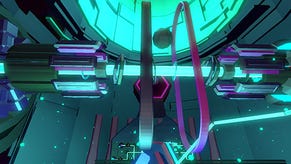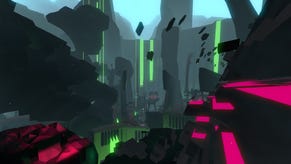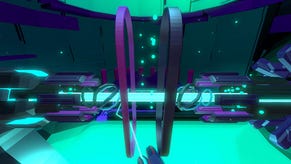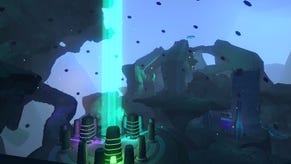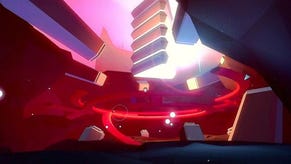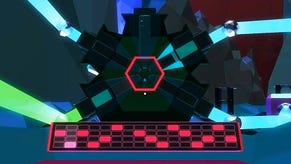Wot I Think: FRACT OSC
Wub of intrigue
Part first-person puzzler, part synthesiser, FRACT OSC has evolved from the mysterious musical toy that won the IGF’s Best Student Game in 2011. It’s now a paid Steam release with a more formal puzzle-game structure in which you explore a vast cave system of disconcerting geometries, full of exotic polyhedral shapes and pulsing neon tubes. Work out how to revive this world and its strange machines, and it throbs with sound and rhythm, unlocking components for a full-fledged music sequencer that you lets you compose and export your tunes. Alec found the whole experience a little austere. Here’s wot I think.
Puzzles are about epiphany, about the joy of understanding something new and achieving mastery of it. It’s what makes a puzzle different from a problem: a problem doesn’t want you to solve it. The best puzzle games need either escalation or variety to carry that sense of epiphany onwards and upwards. They prevent wonder subsiding into routine. And in that sense, FRACT falls short - the more you explore its puzzles, the less interesting they become - but the first few hours in FRACT’s alarmingly alien world may hold wonder enough to buoy you through.
It really is a powerfully disconcerting place: a gigantic cavern into which are sunk dormant machines of unknown purpose, with terrifying, whirring spires and coils that snake off into underground seas. Tron is the easy comparison point, given the game’s angular geometry and high-contrast palette, but this is a queasily weird world quite apart from the snazzy neon urbanity of The Grid. It’s something very other, faintly sinister and possibly mystical.
That sensation you get as you first try to interpret this world and command its systems is what sells the whole game for me - although, by its nature, it’s a sensation that cannot last. The first time you stumble near some strange pod which unfurls in your presence; the first time you grok the critical function of the projected cluster of floating orbs within; the first time the significance of their annotations hits you and unlocks other connotations - these moments of intense interpretation and realisation are scintillating, and all the better for lacking suitable preparation.
There’s an exciting sense of not just exploration into the unknown, but of trespass. It feels like you aren’t really meant to be there - the lack of any explicit introduction to the game’s purpose being compounded by scenery which resists your navigation. The environments are huge and their interconnection difficult to grasp from your lowly vantage point, and there’s a real sense of awe as you stand beneath a glowing ziggurat and wonder how you’re ever going to get to its top. But increasingly, it becomes a bit of a chore. Pitfalls are plentiful, and though plunging into the depths instantly respawns you, it’s easy to tumble through to a lower part of the level and face a long trek back. The game forbids jumping - necessarily so, given some of the puzzles - but it means you can get snagged by inch-high crevices. A menu option to respawn at the last waystation doesn’t always oblige you, and in some instances I’ve had to find ways to kill myself to get back anywhere useful.
But that’s a relatively small and very occasional grievance. A slightly larger one is that the game loses a bit of its lustre when the sense of wonder finally fades and you realise that two of the three major puzzle paradigms are, in essence, Pipemania. That’s a somewhat unfair reduction: they are presented with a startling, discomfiting beauty, and have their own novel twists, but I have perhaps played too many Pipemania games for the underlying formula to keep me riveted indefinitely. I said at the beginning that my favourite puzzle games manage a sort of transcendent escalation: FRACT’s tend to get longer and more arduous. Once the formula is sussed, subsequent levels don’t teach you anything shockingly new, or subvert your expectations, they just ask you to do the same thing again, but with more convolutions.
The third puzzle paradigm is more novel. At its core there’s a block pushing game, but it extrapolates that formula into three dimensions in way which challenges both your spatial and sequential memory. It’s clever, if slightly annoying to solve, as it requires you to loop back around a set of platforms multiple times, making your inconvenient firstperson embodiment one of the puzzle’s limiting factors.
If the puzzles eventually seem a bit flat, then they are enlivened by the fact that they create music. And not just any music, but music which is supposedly unique to you, based on your particular approach. I’m not sure how meaningfully different one player’s music will be from another’s: the major puzzles have a definitive solution, and my feeling is that this generates the main body of the sound, but subsidiary pseudo-puzzles let you input a sequence of notes with some small degree of freedom - and these sequences are then carried throughout the rest of the game in later puzzles. It’s gratifying to have made your own musical stamp in this way, and as you wander the tunnels and caverns, strains of music from your different conquests float past, at times mixing and blending into one singular chorus. The world is coming to life and it’s dancing to your beat. That’s pretty damn cool.
It would be easy to overstate that this is really a game about music creation, though: even in the instances where you get to input notes, you are doing so within the limitations of a puzzle. It is not primarily a creative or aesthetic decision. However, as you progress, you unlock elements in your “studio”, a complicated audio workbench which you can drop back to at any time and interact with as you would any device within the game: in firstperson.
I’m not really qualified to talk about its potential as a music making tool in comparison to dedicated applications - I’ve only dabbled with music sequencers before. However, it does seem that a room full of floating interactive panels viewed in firstperson would not be the most efficient way of presenting such an application.
That said, maybe seasoned electronica enthusiasts will find the same glee in unpicking the studio’s taxonomy as I did deciphering FRACT’s transport system or interpreting the purpose of its first puzzle. This is certainly a game that will hook fiddlers, people who like that sense of anchorless experimentation, extrapolation - the kind you see in the brilliantly enigmatic MirrorMoon, or Steven Lavelle’s mercilessly opaque puzzlers, like English Country Tune. But will FRACT keep them hooked? The game ultimately falls between the stools, being neither quite mischievously obscure art game nor ingenious pure puzzler. But what it has is marvel - momentary, perhaps, in comparison to the game’s overall length, but rare enough in itself. Surely that fleeting experience alone is worth a look and a listen.







